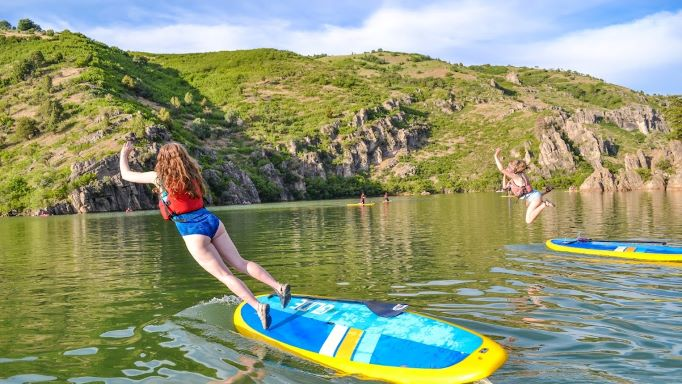
Can You Teach Yourself to Paddle Board?
Can you embark on the stand-up paddleboarding (SUP) journey by yourself? Absolutely! Many aspiring paddleboarders often ponder whether they need formal lessons to get started. While there are scenarios where lessons could enhance your experience, for many, the path to paddleboarding proficiency is well within reach through self-teaching.
Key Highlights:
- Self-Teaching SUP is Feasible: Many beginners can learn paddleboarding without formal lessons, thanks to its straightforward and accessible nature.
- When to Consider Lessons: Group activities or advancing specific skills might benefit from professional guidance.
- Starting on Your Own: Learn the essentials of board positioning, taking your first steps, standing up, and mastering basic strokes.
- The Importance of Practice: Falling and trial are part of the learning process, emphasizing patience and gradual improvement.
- Embracing the Journey: Enjoy the freedom and fun SUP offers, and connect with the community for support and shared experiences.
The Joy of Learning SUP on Your Own
Paddleboarding is uniquely accessible and can be learned without the need for costly lessons. Its simplicity is one of its most appealing aspects. However, there are instances when investing in a lesson might be beneficial, such as group activities or advancing specific skills for more experienced paddlers. But for those just starting, the thrill of self-discovery and the basics of paddleboarding are easily grasped with a little patience and practice.

When to Consider Lessons
- Group Fun: If you and your friends are looking to try something new together, SUP lessons offer a fun way to learn. They provide a structured environment to laugh, learn, and encourage each other while possibly trying out different boards.
- Skill Advancement: For those who've mastered the basics and want to refine their techniques or delve into racing, targeted lessons can offer personalized tips and advanced strategies.

Self-Teaching Essentials
Starting on your own is a straightforward affair. Here’s a quick guide to get you paddleboarding confidently:
-
Board Positioning: Begin with your board in shallow water, placing it so the tail and fin are not facing you. This positioning helps you launch smoothly.
-
First Steps: Either walk into the water and climb onto the board from the side, or start from the nose and gently move towards the center. Once stable on your knees, feel the board's movements and get comfortable with the basics of paddling.
-
Standing Up: When ready, slowly rise to your feet, keeping them shoulder-width apart and knees slightly bent. Focus on finding your balance rather than perfecting your stroke initially.
-
Basic Strokes: With your balance secured, begin to paddle with simple strokes, keeping your center of gravity over the board’s carry handle.
Falling is part of the learning curve, so embrace it with a positive spirit. It's not about maintaining a perfect stance from the get-go but about enjoying the process and gradually improving your skills.

Embrace the Journey
Remember, the objective is to have fun and enjoy the freedom SUP offers. Whether you remain kneeling or find your footing and paddle away, the victory is in the attempt and the joy of being on the water.
For those hungry for more detailed guidance, our website hosts a wealth of articles tailored to beginner paddleboarders. And remember, the Glide community is always here to support your journey. Share your first-time paddleboarding experiences with us using #glidesup on Instagram. Whether it’s questions, triumphs, or tales of unexpected swims, we’re all about celebrating the SUP adventure together
For a more detailed article on how to start to stand up paddle boarding please check out this article.

